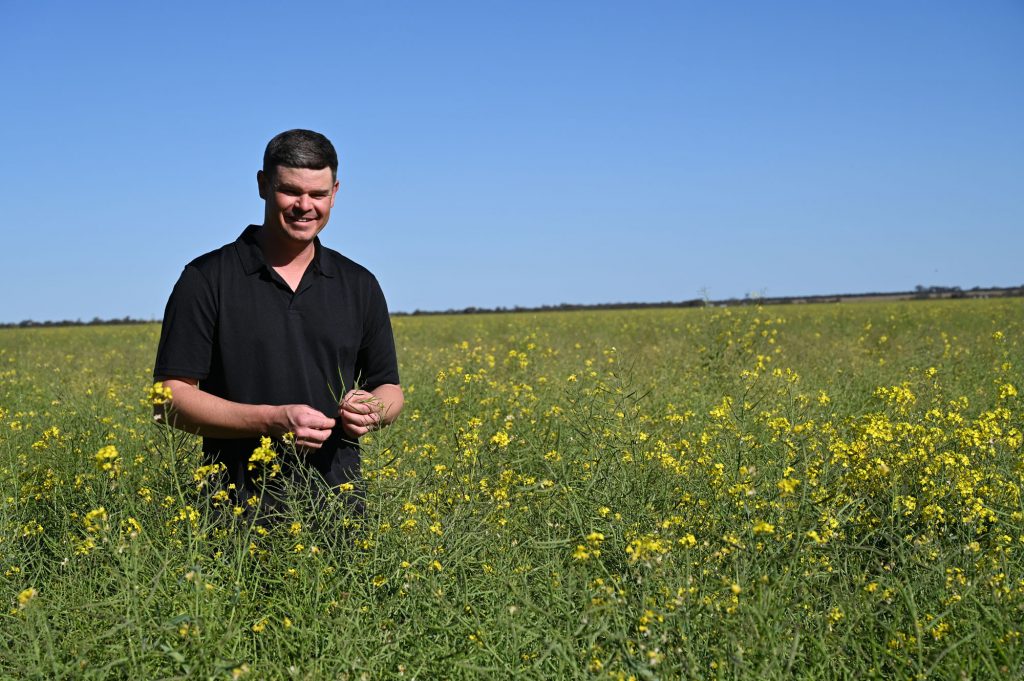“Decisions are made on input costs, labour availability, required machine capacity and inter-operability of machines and their operating software.”
This is where the Laconik Combine™ platform fitted a need for Kim.
“Laconik Combine™ enables us to run our own on-farm trials to determine inputs such as fertilisers to suit our specific farms, to capture variability in our paddocks without relying on trial results from kilometres or maybe districts away.”
“The platform is easily integrated into our software platforms on all our machines- seeder, boom or header. It is simple for Laconik support to access our historic data through our John Deere Operations Centre to generate the following years trial nutrition map for a paddock. This is then easily loaded into our seeders’ variable rate system for us to apply.”
Small fertiliser rate trials are randomly spread across a paddock as ‘swarm trials’ in the first year to capture spatial variation and gauge responses. These are harvested together with the bulk crop and a yield map is generated. A profit gap map can then be generated from the crops response to the fertiliser rate trials. The following year a variable rate fertiliser application map customised to the paddock is generated for application with Kim’s equipment. Over the following seasons, further ‘swarm trials’ can be embedded to refine variable rate fertiliser maps for each paddock.
This means that fertiliser applications are much better matched to paddock variability and can be targeted to areas of maximum return.
“We can see huge potential going forward using Laconik Combine™ to expand farm trials to find our best profit margins.”

About the Graham’s farm
Kim farms a 2,200-hectare property with his wife Beth. Their average rainfall is 280 millimetres a year and they deal with a medium frost risk. Their soil types are quite variable ranging from wodjil to salmon, mallee and gimlet with pH ranging from four to seven.
Kim’s grandfather used to farm in the region and Kim has accessed his rainfall data going back some 70 years.
“This has provided us with useful historic data to ascertain the rainfall changes and risk we are dealing with to plan our cropping program,” Kim says.
“Our typical crop sequence is barley, fallow or lupin followed by wheat.”
“Fallow is a big part of our moisture retention program and each year we would have around 30 per cent of the property out to fallow.”
Typical wheat yields are 1.3 tonne per hectare and 1.6 tonnes per hectare for barley. Granular and liquid fertilisers are used by Kim with in-crop liquid nitrogen top ups.
Kim can see that the Laconik Combine™ platform will enable him to make much more informed decisions about fertiliser rates and application.
“Over the years we have applied fertiliser at blanket rates of six units of phosphorus and 25 units of nitrogen over the whole farm. Now we are more aware of our soil types and profiles and need to be applying our nutrition accordingly for our best profit margin.”
Using Laconik Combine™ trials and the following up with tailored fertiliser prescription maps Kim estimates that he can save around 30% on costs in non-responsive areas.
“This makes Laconik Combine™ a great tool for delivering nutrition to the right areas and soil types for best results.”
Kim and Laconik Combine™
“Darren Hughes, the founder of Laconik is a can-do man with great initiative and positive energy to match. Our experience with Laconik is that it is very efficient and this has made it a real pleasure to work with. We can see it having a big positive impact on our business going forward.”
“The system is effective and efficient – very easy to use. If we make real time changes to our cropping program and decide to bring a paddock into crop during our seeding program we have been up and running within hours of contacting Laconik to set up nitrogen trials in that paddock.”

Kim says the Laconik Combine™ platform interfaces easily with his machines software and enables him to make the best use of current technology that he already has to get the best out of cropping in his environment.
“Laconik provides simple solutions to enable us to create trials and prescriptions and improve our yields and margins in farming. We already have the technology so we might as well be using it to its full potential.”
